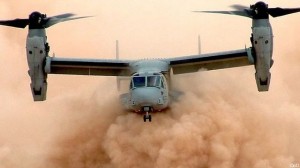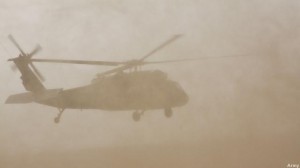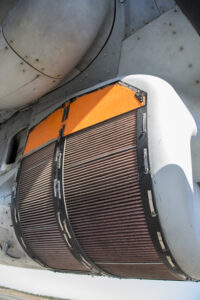Fatal Crash Prompts Marines To Change Osprey Flight Rules
Posted on

CORRECTION: THE ARTICLE WAS WRONG IN SAYING THE OSPREY SHOULD HAVE BEEN ABLE TO HOVER ON ONE ENGINE
WASHINGTON: Marine Corps leaders have issued a fleetwide order to MV-22 pilots to wave off any landing in a dust cloud they can’t complete within 30 seconds, Breaking Defense has learned, a reaction to a fatal accident in Hawaii on May 17. The previous rule was 60 seconds, though experienced Osprey and helicopter pilots usually spend no more than 10 seconds or so in such risky conditions.
Investigators are still studying the training flight mishap in which an MV-22B Osprey‘s hard landing killed two Marines aboard. They have yet to officially declare the crash’s cause, but BD has learned that the plane suffered reduced power in both engines and a compressor stall that knocked the left one out entirely after spending an unusually long 45 seconds hovering over a dusty landing zone.
The Marines issued the new flight rules based on tourist videos of the accident, data downloaded from onboard systems, and testimony from survivors,
Osprey pilots have been ordered to monitor engine performance during Reduced Visibility Landing (RVLs) and to brief all “engine failure in a hover” procedures to all aircrew prior to flying RVL training flights or missions in which such a landing is possible.
RVLs, common for the tiltrotor Osprey and helicopters as well, occur when rotor downwash kicks up clouds of dust, sand, snow or other debris that obscure the crew’s view of the ground. A significant number of the more than 420 U.S. military helicopters that have crashed since 2001 occurred in such conditions.
The Osprey often encounters those conditions because of the powerful downwash created by its “proprotors,” whose diameter is smaller and whose blades have more twist than helicopter rotors so they can serve as propellers in forward flight.
Unlike all but the most modern helicopters, the MV-22B has electronic flight controls and a “glass cockpit” with a “Hover Page” and a “Flight Director” – an autopilot function — that can be coupled to help in RVLs. The Hover Page shows the pilot a “lollipop” – a circle with the aircraft at its center and a line pointing to the desired landing spot, which is designated by grid coordinates the aircrew enters in advance.
To eliminate the risk of drift, a pilot with sufficient time can put the aircraft into a hover above the cloud of dust or debris kicked up by its proprotors – usually 50 feet above ground level – and couple the Flight Director to the Hover Page to automatically land the aircraft. Sometimes the Flight Director and Hover Page fail to properly couple, however, forcing pilots to repeat the procedure.
CORRECTION BEGINS: The Rolls-Royce AE 1107C engines on the Hawaii plane ingested dust or debris that left the right engine of the Hawaii Osprey too weak to keep the craft airborne — as it should have been able to do — after the left engine failed. The Osprey can fly on one engine like an airplane or even with the rotors angled upward somewhat, but only with the lightest possible load, under ideal conditions and at low altitude could a V-22 hover on one engine. In the Hawaii mishap, the right engine lacked enough power to stop the aircraft from falling after the left engine failed. CORRECTION ENDS.
One factor may have been that the landing was one of several the aircraft made that day at the same dusty zone. The Osprey also was hovering “out of ground effect,” which requires more power than hovering where downwash reaches the ground quickly. Also, the aircraft had 22 Marines aboard and thus was heavily loaded.
The accident also appears to reflect the chronic inadequacy of the V-22’s Engine Air Particle Separator (EAPS), a filter at each engine inlet that was modified years ago after suffering hydraulic leaks that caused fires and still allows far more dirt than is healthy to pass into the Osprey’s engines. The EAPS may be replaced by a new filter being developed by Bell Helicopter Textron Inc., which makes the Osprey in a 50-50 partnership with Boeing Co. But that won’t happen until 2017 or after under current plans.
Subscribe to our newsletter
Promotions, new products and sales. Directly to your inbox.

